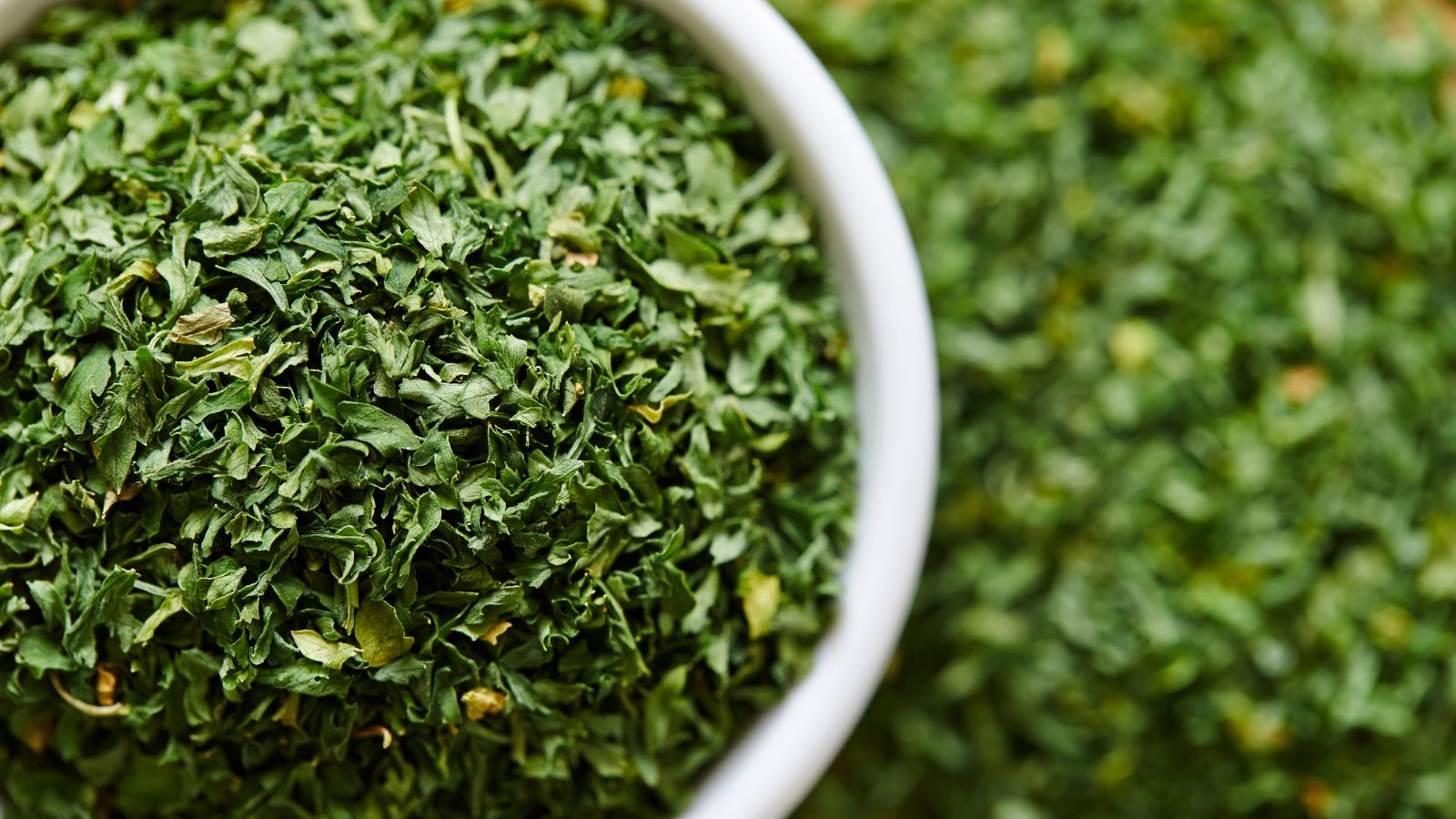
Can Bearded Dragons Eat Parsley? What Every Owner Should Know
Photo Credit: Canva Pro
Can bearded dragons eat parsley? Yes, but only in very small amounts and not frequently. Although parsley has some health benefits, giving your dragon too much of it can be bad for them. Calcium loss could happen, which could lead to health problems like metabolic bone disease.
This article tells you when it's okay to feed your bearded dragon parsley, which greens are better, and how to make sure that your bearded dragon's diet is balanced. To keep your dragon healthy, happy, and eating the right things, keep reading.
Could Bearded Dragons Eat Parsley?
Photo Credit: Canva Pro
Is Parsley Safe for Bearded Dragons to Eat?
Can bearded dragons eat parsley? Yes, but only occasionally. Parsley is not toxic, but it is not ideal due to its high oxalate content, which reduces calcium availability. For adult bearded dragons, parsley can be offered sparingly as a garnish, but never as a staple.
-
Offer small amounts: 1–3 grams per serving.
-
Feed occasionally: No more than once a month.
-
Best for adult dragons: Not recommended for young beardies.
-
Watch calcium intake: Balance with calcium supplementation and UVB light.
Nutritional Breakdown and Risks of Parsley
Parsley offers vitamins A and C. However, its high oxalate levels make it risky when not balanced correctly, as oxalates bind to dietary calcium, making it unavailable for absorption.
-
Calcium binding: Oxalates can cause serious deficiencies.
-
Vitamin-rich: Includes vitamin A and C for immune system support.
-
Risk of health issues: Feeding too much parsley without adequate calcium or UVB exposure may contribute to metabolic bone disease over time.
-
Feed with care: Only as part of a varied and calcium-rich diet.
What Herbs Are Safe for Bearded Dragons?
Photo Credit: Canva Pro
Weekly-Friendly Herbs for Beardies
Bearded dragons can safely eat many herbs once a week, and doing so can help their health in general. Because they are high in vitamins and antioxidants, basil, cilantro, rosemary, and chicory are great salad greens to mix with basic greens like collard greens, mustard greens, and turnip greens.
-
Basil: Offers vitamins A, C, E, and K.
-
Cilantro: High in calcium and vitamin C.
-
Rosemary: Good fiber and excellent calcium to phosphorus ratio.
-
Chicory: Rich in iron and fiber for digestion.
Herbs to Use Occasionally
Herbs like parsley, mint, and thyme can be healthy, but because they are acidic or high in oxalates, they should only be used occasionally. To keep calcium absorption problems and digestive stress from happening, these herbs should be rotated carefully and never in large amounts.
-
Parsley: Feed no more than once a month.
-
Mint: Refreshing but can upset digestion in large amounts.
-
Thyme: High in antibacterial properties, but acidic.
-
Rotate wisely: Combine with safer, weekly herbs.
Is Parsley Safe for Reptiles in General?
Photo Credit: Canva Pro
Parsley’s Effects on Reptile Health
Parsley isn’t toxic to reptiles, but it’s nutritionally risky. The oxalates in it make it bad for them when they eat it a lot. These compounds link to dietary calcium, making it unavailable for absorption. This is very important for reptiles like bearded dragons that get their calcium from outside sources and UVB exposure to stay healthy.
-
Oxalates interfere: Block calcium absorption in reptiles.
-
Nutrient loss: Even with good nutrients, they may go unused.
-
Long-term risk: Increases chance of metabolic bone disease.
-
Best in moderation: Use parsley as a garnish, not a staple.
Better Reptile Herb Alternatives
Provide safe and low-oxalate greens instead of parsley. As an alternative, dandelion, mustard, and turnip greens are great options that are high in calcium, fiber, and other important nutrients.
-
Dandelion greens: High in calcium and fiber.
-
Mustard greens: Less acidic, great calcium support.
-
Turnip greens: Balanced and rich in nutrients.
-
Offer greens: Mix with occasional herbs like cilantro or basil.
Is Parsley Toxic to Animals?
Photo Credit: Canva Pro
Is Parsley Considered Poisonous?
Parsley is non-toxic to most animals, including reptiles. Pet owners should know that "non-toxic" doesn't mean "risk-free." It is safe to use in small amounts. For bearded dragons, it's not just about keeping them safe, but also about making sure they get sufficient nourishment.
-
Non-toxic: Not dangerous in small amounts.
-
Safe for reptiles: Can be eaten without immediate harm.
-
Use caution: Still not ideal in large quantities.
-
Combine smartly: Use alongside better greens like romaine lettuce or sweet potato.
Difference Between Toxic and Nutritionally Risky
Due to its oxalates, parsley is bad for the beardie's health because it can throw off its nutritional balance.
-
Toxic vs. risky: Toxic kills, risky causes slow damage.
-
Long-term use: Can impair growth and bone health.
-
Watch beardie's age: Younger dragons are especially vulnerable.
-
Manage with care: Feed parsley only as a rare treat.
What Vegetables Can a Bearded Dragon Not Eat?
Photo Credit: Canva Pro
High-Oxalate and Goitrogenic Foods to Avoid
Bearded dragons shouldn't eat certain vegetables because they naturally have a lot of oxalates or goitrogens. If these compounds are given on a regular basis, they can stop their body from absorbing calcium or mess up the thyroid's function, which can lead to long-term health problems.
-
Spinach: High in oxalates; avoid.
-
Beet greens: Same risk as spinach.
-
Swiss chard: Oxalate content too high.
-
Kale: Use rarely due to goitrogens.
-
Manage diet: Focus on safer veggies like butternut squash.
Low-Nutrient or Unsafe Vegetables
Vegetables like iceberg lettuce and cabbage offer little nutritional value and may introduce risks due to pesticides or water content. To help their bones grow and their organs work right, bearded dragons need vegetables that are high in nutrients.
-
Iceberg lettuce: Mostly water, zero benefit.
-
Cabbage: Contains goitrogens; disrupts hormones.
-
Wild plants: May carry toxins or pesticides.
-
Romaine lettuce: Better than iceberg, but still low calcium.
-
Stick with: Bell peppers, sweet potato, and turnip greens.
Meet FullyHealthy – Where Nutrition Meets Peace of Mind
What is FullyHealthy?
FullyHealthy is an online platform dedicated to supporting clean eating and health-conscious diets. There are allergen-free and AIP-compliant foods, like plants like parsley flakes, that are great for pet owners who want to make sure that both they and their pets can eat safely.
-
Allergen-friendly: Great for sensitive households.
-
AIP-compliant: Autoimmune protocol safe.
-
Versatile pantry: From humans to pet-safe herbs.
-
Known for quality: Clean ingredient sourcing.
-
Ethical and accessible: Small brands, transparent labels.
Why Pet Owners Trust FullyHealthy
FullyHealthy cares about the safety of its ingredients, especially when choosing herbs like parsley. Clear labels and quality standards help reduce health risks, making it easy to feel confident about occasional treats.
-
Transparent sourcing: Know what you’re feeding.
-
Small brands supported: Ethical, vetted suppliers.
-
Includes dried parsley: Easy to measure and portion.
-
Trusted by pet families: Clean and simple products.
-
Beyond pets: Family-safe foods for every shelf.
Final Thoughts
It's okay to give bearded dragons some parsley once in a while, but can they eat it every day? Absolutely not. Too much parsley in the diet raises the chance of metabolic bone disease, especially when fresh parsley is given in large amounts without enough calcium. A smart bearded dragon's diet includes dandelion greens, turnip greens, romaine lettuce, and fresh greens, not just herbs.
Maintain your dragon's terrarium clean, manage humidity levels, and avoid using loose substrate. Carefully observe your bearded dragon's age and any health problems. Make smart choices for your dragon.
FAQs
Can bearded dragons eat parsley with dubia roaches and super worms?
Yes, but feeding parsley should be rare and always combined with insects like dubia roaches, super worms, or live mealworms from pet stores.
Is fresh parsley okay in a bearded dragon's terrarium with wax worms?
Fresh parsley can be served in small amounts, but not kept in the bearded dragon's terrarium near wax worms or food.
Does feeding parsley cause metabolic bone disease in adult dragons?
Parsley alone doesn’t directly cause MBD. It contributes to it when combined with low calcium intake and poor UVB exposure
What fresh greens are better than parsley in a beardie's diet?
Dandelion greens, romaine lettuce, turnip greens, and bell peppers are better for a beardie's diet than eat parsley.
Can dragons eat crickets, wild bugs, and parsley during bath time?
Dragons eat crickets and wild bugs anytime, but feeding parsley or other greens during bath time is not smart.

Leave a comment